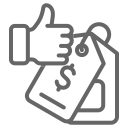This report deals with the various tools and strategies which are accessible for countries to move towards circular economy. Circular economy helps to use the resources again and again which leads to the full utilization of the resources and the waste part is removed. Due to these reasons, the countries are more attracted towards the circular economy. Due to the high prices of resources, the companies are facing various challenges. Simultaneously, one more challenge which the countries are facing is the unpredictable prices of several resources. Circular economy assists in the reduction of cost of resources and help to make the production easy and economical.
A movement towards a circular economy grasps main abilities for the environment and may possibly increase the competitiveness amount in countries. Countries may decrease cost up to a limit by using the ability of production in a better way. It helps to use fewer resources in production and design. It also assists in increasing the rate of recycling and decreasing wastes. The world is continuing towards modernization, therefore there are various challenges related to the sustainable development in the countries. Also, there is a need to search for novel resolutions. There is an increasing requirement to recognise and implement novel models and growth strategies.Present financial and development tendencies place signi?cant force on the country resources, infrastructures and systems, and also demand novel methods in ?nancing, governing, and observing performances (Kalmykova et al. 2018).
Recognizing and applying novelgrowth models and tacticsareessential in facing numerous challenges linked to the overall rise in costs. The circular economy provides a view to decrease the costs due to the conversion of the accumulation economies into accumulation diseconomies and to bring the sustainable development philosophies into operation.In a circular economy of a country resources and items are recirculating, their worth is fully used, and the wastage is reduced. The products are prepared in such amanner that they can be repaired, reused and reused rather than being wasted. A circular economy helps to rapidly grow sustainable and resource-effective production. Because of these advances the countries are planning to move towards the circular economy. There are various strategies and tools which are helpful in this movement(Petit-Boix and Leipold 2018). The countries are having an aim to encourage circular economy, comprising of better usage and recycling of resources and the stoppage of waste. This research paper deals with the tools and strategies which are accessible for the countries to transfer towards the circular economy.
In the present scenario, countries are noticing that the system of linear consumption has enhanced the risk exposure due to the high prices of resources and supply disturbances. There were no or very low innovative technologies due to which the countries felt enfolded among the increasing and fewerexpectedvaluesof resource marketplaces. On the other hand, there was a high competition and deteriorating demand for some segments (Petit-Boix and Leipold 2018). The main concern roused when the actual prices of the natural resources started climbing up. The level of the cost volatility for food and non-food products and metals in the 1st era of the 21st century were greater than in any solitary era in the 20th century. There is a need to take an action since without any action greater cost and volatility will be present. This will happen if there is robust growth, the citizens of the country develop and urbanise and also the price of resource extraction rises. Till the year 2030, there is a chance of enormous consumers entering in the marketplace but the signals of price are not very strong which can turn the condition so that it meets this development requirement. Therefore the countries are in search of better economic model which can increase the economy of the country. In this way, circular economy can serve the purpose well.
There are various countries which have adopted the highest scores for the circular economy which includes United Kingdom, Germany and France. These countries have strong recycling systems and higher level of novelty in the circular economy segments. It can be witnessed the resources are diminishing at a higher rate on earth. It can be stated that in future the demand of human beings will increase than what the nature can serve. Therefore, there is a need to reinvent resources so that before getting late the resources can be saved for future use. In different countries, mainly the business operations impose influence on the society. It is necessary to evaluate these influences (Bocken et al. 2016). As soon as it is realized by the country that there is scope for reducing the environmental influence, the country get an entry point for the circular economy. Various strategies for the transition towards the circular economy include:
1. Reinforce companies as a driving force for circular conversion: The industries should focus on the optimal use of present technologies which can reduce the resource cost. For increasingthe entree to novel marketplaces and improve competitiveness, companies will have an advantage from concentrating on the growth of circular economy and services. Companies may increase thetrade by designing modules in a way that they have an extended valuable life and are willingly fixed and recycled(Foster 2020).Companies may make more worth from the same capacity of resources, for example through more well-organized usage of resources in their manufacturing.
Initiative 1: Sponsoring circular business expansion in SMEs
Initiative 2: Setting up a solitary point of entry to the specialists for companies with circular business models
Initiative 3: Increasing the access to finance of circular business models
2. Supporting circular economy over data and digitalization: With the help of digitalization, huge volume of data supports towards the conversion to a circular economy. This will help in reducing wastage with the use of 3D sensors and printers (Giorgi et al. 2019). The smart technologies which can be used are internet of things, big data and digital sharing economy platforms. Also, improved recycling can be attained with the help of enhanced traceability and categorization of resources utilizing Block Chain and robots. Also, community and private companies may progressively utilize ecological information to succeed and take decisions.
Initiative 4: Contributing digital circular decisions by business usage of information and challenges
3. Promoting circular economy overdesign: For the transition towards the circular economy the design of the products is very important. The main reason is that in the design process the main decisions regarding the resources are taken which is for the lifetime of the product. Additionally, much of the decisions about a product are made in the design phase(Leising et al. 2018). The design made with the circular economy will maximize the worth of the resources and services with the emphasis on restricting the resources consumption and enhancing the lifetime by repairing and recycling.
Initiative 5: Including circular economy into product strategy
Initiative 6: Boosting companies to work on circular standards
4. Changing consumption designs over circular economy: With the help of modification in consumption and patterns of consumption the companies, public sector and citizen can contribute in the marketplace for circular economy. The utilization rate can be increased by sharing or leasing the products. By using the circular economy, it is a way to save money and enhance recycling (Wastling et al. 2018). Simultaneously, it turns out to be progressively appealing for designers and makers to think in circular ways, and by fixing and keeping up consistently it is possible to grow the lifetime of things.
Initiative 7: Endorsing circular procurement
Initiative 8: Enhancing emphasis on total price of possession in public procurement
5. Creating a proper operational market for waste and reused raw materials: Even if the circular economy is used then also the waste will be produced. For enhancing the use of circular economy more incentive should be given for recycling the waste and guaranteeing high-quality recycling so that it produces the maximum possible worth and the lowermost possible ecological burden. A waste management segment open to competition and an appropriate operational market for waste and recycled raw resources may have an adverse effect on the circular economy(Virtanen et al. 2019). This is due to the reason that it gives companies a better access to value wastes and competition for the finest solutions. Also, more consistent circumstances and implementation of rules will generate a level field for companies all over the country.
Initiative 9: Endorsing more harmonized group of household waste
Initiative 10: Generating a level playing field on the marketplace for waste and recycled raw resources
Initiative 11: Liberalizing WEEE organization
Initiative 12: Creating a pool for the management of regulatory blockades to circular economy
6. Getting more value out of constructions and biomass: The food industry, construction and building sector have more economic and environmental abilities for circular economy in any country. These companies generates around one third of all the waste arouse in any country. Also, huge portions of this waste are recovered at a low value. The market for reused crude materials can be supported by isolating the waste that contain substances of concern and by getting hold of the important materials emerging when structures are obliterated and dismantled. In the food business biomass for example buildups from agribusiness, fishery, forestry and creation of food can be changed over into natural parts that can be recuperated for different purposes(Winans et al. 2017). For instance, through bio refining of biomass it is conceivable to deliver sugar, fat, methane, and proteins that can enter the creation of pharmaceuticals, food, resources, and vitality.
Initiative 13: Emerging a voluntary sustainability class
Initiative 14: Spreading selective destruction
Initiative 15: Receiving more value out of biomass
The new model of circular economy in the countries helps to achieve low prices of resources. These tools are main resources for representatives to allow them to get holds with the difficulty of this developing area and make path maps that will assist the move from linear to circular. Various tools and instruments have been made to ease the change in the direction of a more circular economy. These tools include:
1. Level(s): Constructing sustainable performance: Level(s) is a controlled reporting framework which helps to increase the sustainability of buildings. Utilizing present values, Level(s) offers an EU-wide method to assess the ecological presentation in the built structure(Ghisellini et al. 2016). It inspires life cycle thinking for the whole structure by providing a step by step method to life cycle valuation.
Level(s) in the circular economy
For any country the building sector is a huge consumer of resource. It consumes around half of the resources extracted, energy and around one third of water. Also, it produces around one third of the waste. There are different environmental pressures of a building's life-cycle. This simply means that the building sector delivers more potential for fixing up a circular economy (Saavedra et al. 2018). There is more chance for the sustainable design of the building, repair, construction, maintenance, and recycling and reuse of resources in the buildings. The Action Plan comprises fan action on the valuation of the ecological performance of buildings. To support such valuation, there is a framework with indicators, called as Level(s).
2. EU Eco label: Sustainable products and services: EUEco label is a controlled label that assists to recognize services and products which havedecreased their ecologicalinfluencethrough their whole life cycle. It permits customers to make informed selections and rewards creators who make efforts to generate sustainable products.
EU Ecolabel in the circular economy
The EU Ecolabel gives rewards to themanufacturer who chooses to make repairable and durable, promoting novelty and saving resources. Any services which are awarded as the EU Ecolabel meets a set of high biological and performance standards. The EU Ecolabel has in fact acts as a leader in endorsing circular economy, as the standards to be obeyed by the numerous services or products or which are on the basis of thekeyvalues of the circular economy.
3. ETV: EUEcological TechnologicalConfirmation: ETV is novel devices which assist in inventive ecological technologies reach the marketplace. This circular economy instrument offers third-party confirmation of the performance of skills, building trust amongst potential consumer sat the same time decreasing technical risk.
ETV in the Circular Economy
Novel, well-organized and consistent ecological skills requires coming into the marketplace for the effective circular economy acceptance. The validation process permits a self-governing valuation and authentication of the manufacturer's rights on the performance and ecological profits of their skill (Ili? and Nikoli? 2016).The datadelivered by ETV over the clear, robust and self-governingprocedure can be valuableespeciallyan to small business that desires to arrive and disturbmarketplaces. ETV may be usedamongst others to includenewrequirements in supply chains and public procurement. The Action Plan of EU Circular Economy is fixed to endorse competence and updates of ETV specifically in supporting novelties by SMEs.
4. EMAS:Eco-Management and Audit Structure: EMAS is the authorized environmental management tool which assists companies to enhance their ecological performance and show their efforts to deploy "reuse, reduce and recycle” policies.
EMAS in the Circular Economy
With the help of EMAS the companies can count the use of the resources, make plans to enhance their ecological performance, reach ecological aims, and form more effective management process. EMAS can be adopted by any company of the country for improving its ecological performance. It is present across all financial and service segments and is applicable universally. EMAS can be helpful for facilitating companies in shifting to the Circular Economy (de Jesus et al. 2019). EMAS provides companies the tools for saving money and resources of all types by presentingnumerousactions, which includes increasing energy and water efficiency, reducing wastes and resource usage, and presenting “reuse”, reduce” and “recycle” practices. It is observed that the EMAS is providing more options for economic savings in the circular economy.
5. PEF-OEF:Product Ecological Footmark and Organization Ecological Footmark: Product Ecological Footprint (PEF) and OrganizationEcological Footprint (OEF) are complete tools which help toevaluate and inform consumers about the ecologicalinfluence of products and companies. Their method of measuring life-cycle shows the spirit of the circular economy.
PEF-OEF in the Circular Economy
As the consumers are more aware of the ecological consciousness they are attracted towards buying green products. Though, the existing marketplace provides a huge variety of ecological labels and schemes which leads to the misunderstanding and distrust in ecological performance information. On the other hand, creators of green products in order to show their ecological performance and enter the nationwide marketplaces require applying approaches that are legal in these countries. These approaches are on the basis of the life cycle valuation and identify the significance of addressing ecological influences through the whole supply chain of product/organization in a combined manner. The life-cycle view of the PEF and OEF shows the spirit of the circular economy. This means by addressing the influence on every stage of the life cycle, PEF and OEF addresses improved design of products, decline of resources usage and wastesprocessing. They allow businesses to improve their circularity plans, concentrating on their efforts, that is the decline of the most applicable influences related to their products/organizations (Ngan et al. 2019).It is imaginary that PEF and OEF will support to circular economy growth in the EU by providing a strong cross-border marketplace to improve to products and stronger competitive place to businesses evaluated following the EU harmonized approaches.
6. GPP: Green Public Procurement:GPP is aninfluential circular economy tool that inspires request for green products and facilities by endorsing green marketplaces and to set strong instances for community to follow.
GPP in the Circular Economy
GPP is a controlled tool. It is having a main role in the EU's conversion to a circular economy which has been documented in the circular economy package. It can increase request for resource recyclability, effectiveness, durability, repairable products, and endorse novel commercial model which are based on offering functions and facilities as a substitute of selling products. Also, Green Public Procurement permits regional, local, and nationwideestablishments to set instances to follow for industries and business (Ferronato et al. 2019). The Circular Economy Package fixes out numerousimportantactions on GPP, like making circularity requirements strongin the EU GPP standards, and providing teachings on the circular economy.
These are the various strategies and tools which assist a company to move towards the circular economy.
It can be concluded from the above report that circular economy is of great importance for the countries. Most of the nations are facing different challenges due to the high prices of the resources. The prices of the resource are unpredictable which imposes more risks on the companies and hence it affects the economy of the country. With the assistance of circular economy, the cost of the resources decreases and the production can be carried out in a more effective manner. Circular economy helps to use lesser resources as it increases the use of recycled resources. There are various strategies which helps the countries in moving towards the circular economy. This report explains various tools and strategies which supports the movement of the country towards circular economy. It is observed that the resources are diminishing at a higher rate on the planet. So, by using the recycled resources, the resources can be saved for future purposes.
In this way, circular economy is very beneficial. In some cases, it does not take a technical development to have an effect in the country. Urging purchasers to reuse merchandise and coordinating reusing at the corporate level are incredible spots to begin. With the help of this idea of development from utilization is isolated. It can be considered as a take-off from the manner in which numerous organizations work. A circular economy serves to quickly become sustainable and resource-efficient production. As a result of these advances the nations are intending to move towards the circular economy. There are different techniques and instruments which are useful in this development. The nations are having an intension to empower circular economy, so that it can help in better utilization and reusing of resources and the stoppage of waste. The report explains the importance of the circular economy which forces the nations to adopt it.
Bocken, N.M., De Pauw, I., Bakker, C. and van der Grinten, B. 2016. Product design and business model strategies for a circular economy. Journal of Industrial and Production Engineering, 33(5), pp.308-320.
de Jesus, A., Antunes, P., Santos, R. and Mendonça, S. 2019. Eco-innovation pathways to a circular economy: Envisioning priorities through a Delphi approach. Journal of Cleaner Production, 228, pp.1494-1513.
Ferronato, N., Rada, E.C., Portillo, M.A.G., Cioca, L.I., Ragazzi, M. and Torretta, V. 2019. Introduction of the circular economy within developing regions: A comparative analysis of advantages and opportunities for waste valorization. Journal of environmental management, 230, pp.366-378.
Foster, G. 2020. Circular economy strategies for adaptive reuse of cultural heritage buildings to reduce environmental impacts. Resources, Conservation and Recycling, 152, p.104507.
Ghisellini, P., Cialani, C. and Ulgiati, S. 2016. A review on circular economy: the expected transition to a balanced interplay of environmental and economic systems. Journal of Cleaner production, 114, pp.11-32.
Giorgi, S., Lavagna, M. and Campioli, A. 2019. Circular economy and regeneration of building stock in the Italian context: Policies, partnership and tools. In IOP Conference Series: Earth and Environmental Science (Vol. 225, No. 1, p. 012065). IOP Publishing.
Ili?, M. and Nikoli?, M. 2016. Drivers for development of circular economy–A case study of Serbia. Habitat International, 56, pp.191-200.
Kalmykova, Y., Sadagopan, M. and Rosado, L. 2018.Circular economy–From review of theories and practices to development of implementation tools. Resources, conservation and recycling, 135, pp.190-201.
Leising, E., Quist, J. and Bocken, N., 2018 Circular Economy in the building sector: Three cases and a collaboration tool. Journal of Cleaner production, 176, pp.976-989.
Ngan, S.L., How, B.S., Teng, S.Y., Promentilla, M.A.B., Yatim, P., Er, A.C. and Lam, H.L. 2019. Prioritization of sustainability indicators for promoting the circular economy: The case of developing countries. Renewable and Sustainable Energy Reviews, 111, pp.314-331.
Petit-Boix, A. and Leipold, S. 2018. Circular economy in cities: Reviewing how environmental research aligns with local practices. Journal of Cleaner Production, 195, pp.1270-1281.
Saavedra, Y.M., Iritani, D.R., Pavan, A.L. and Ometto, A.R. 2018. Theoretical contribution of industrial ecology to circular economy. Journal of Cleaner Production, 170, pp.1514-1522.
Virtanen, M., Manskinen, K., Uusitalo, V., Syvänne, J. and Cura, K. 2019. Regional material flow tools to promote circular economy. Journal of Cleaner Production, 235, pp.1020-1025.
Wastling, T., Charnley, F. and Moreno, M. 2018. Design for circular behaviour: considering users in a circular economy. Sustainability, 10(6), p.1743.
Winans, K., Kendall, A. and Deng, H. 2017. The history and current applications of the circular economy concept. Renewable and Sustainable Energy Reviews, 68, pp.825-833.
Remember, at the center of any academic work, lies clarity and evidence. Should you need further assistance, do look up to our Global Economy Assignment Help Australia
You Might Also Like
Explain the Relationship Between Consumption and Saving
Wildlife Populations and the Health of Production Animals

Get 24x7 instant assistance whenever you need.

Get affordable prices for your every assignment.

Assure you to deliver the assignment before the deadline

Get Plagiarism and AI content free Assignment

Get direct communication with experts immediately.
Get
500 Words Free
on your assignment today

It's Time To Find The Right Expert to Prepare Your Assignment!
Do not let assignment submission deadlines stress you out. Explore our professional assignment writing services with competitive rates today!
Secure Your Assignment!